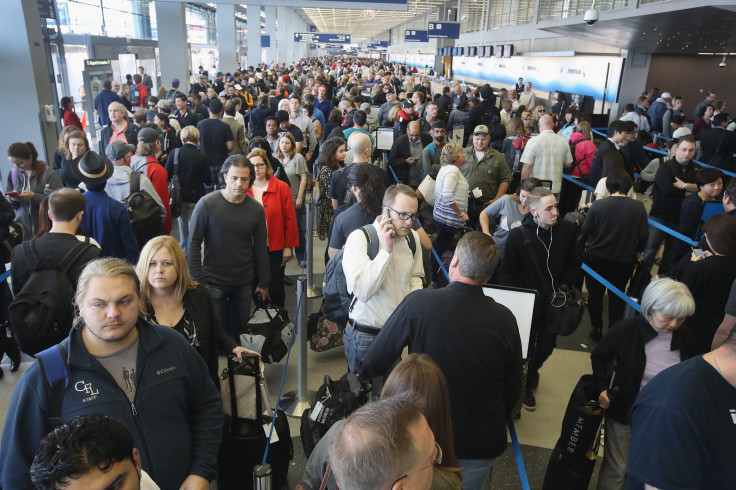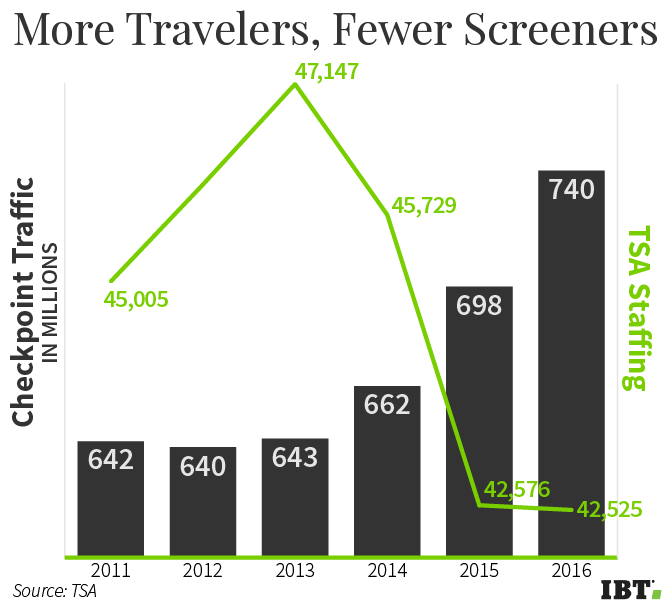TSA Airport Wait Times: The One Big Reason Why Lines Are Getting Longer At Security Checkpoints

As airport security lines around the country have grown almost unmanageable, Washington has found no shortage of blame. Is it mismanagement at the Transportation Security Administration? Underfunding by Congress? Flaws in the original, post-9/11 legislation establishing the TSA and giving the agency its mandate?
The answers to those questions are the source of ongoing Capitol Hill drama, which has already seen the TSA’s security chief Kelley Hogan ousted. But as travelers look ahead to the Memorial Day weekend, one chart explains why passengers are waiting as long as two hours in airport security lines.

As the number of travelers has grown since 2011, the number of TSA screeners has failed to keep pace. Between 2011 and 2016, checkpoint traffic has increased 15 percent, to an expected 740 million passengers this year. Meanwhile, the number of screeners has fallen nearly 10 percent from a peak of 47,147 in 2013.
“The issue is that TSA simply does not have adequate funding in its budget for enough screeners,” said Henry Harteveldt, travel industry analyst and founder of Atmosphere Research Group.
Taken together, these trends mean a 22 percent rise on average in the number of passengers each TSA screener needs to check in a single day.
“The stress on the flying public is felt most severely by airline and airport personnel,” said Rep. Bennie Thompson, D-Miss., during a House hearing on TSA failures Wednesday. “Unfortunately, it is men and women who are the face of TSA who get blamed.”
That’s not the end of the story, of course. Government audits have found widespread problems at the agency, ranging from mismanagement of staff to inefficient processes to abuse of whistleblowers. Morale at the TSA is lower than any other government agency, these audits have found, with one low-paid screener leaving for every two the agency hires.
There are also shifting priorities at play. Efficiency concerns took a backseat to a focus on security in the last year, after an internal review found that screeners failed 95 percent of the time to catch illicit materials being sneaked through security by auditors posing as potential criminals.
Budget cuts have played a role in reducing the TSA’s ability to effectively staff airports. In 2014, Congress voted to divert a portion of airline fees from TSA to deficit reduction, a decision that will cost the agency $1.25 billion this year — the equivalent of about 17 percent of the TSA’s 2016 budget.
But that’s not the whole story, Harteveldt said. In some ways, the agency has been its own worst enemy.
In 2011, the TSA established its PreCheck program, allowing some passengers to apply for expedited service. In its pitch to Congress, the TSA said PreCheck would relieve lines, requiring fewer screeners. But the program didn’t ramp up nearly as quickly as expected, enrolling roughly a third of the 30 million passengers the agency hoped would have applied by now.
“You’ve got more people flying, you have fewer people than expected enrolled in the PreCheck program, and you have fewer screeners available,” Harteveldt said. “It is really the perfect storm.”
TSA chief Peter Neffenger has taken steps to address the long lines in advance of summer, promising progress. The TSA last week won approval from Congress to move $34 million of its budget toward hiring 768 more screeners, and the agency plans to install automated bin systems like those in place in airports around the world so that TSA employees don’t have to spend their time wrangling containers.
“We have a challenge this summer which we are meeting head-on,” Neffenger told Congress Wednesday.
© Copyright IBTimes 2025. All rights reserved.






















